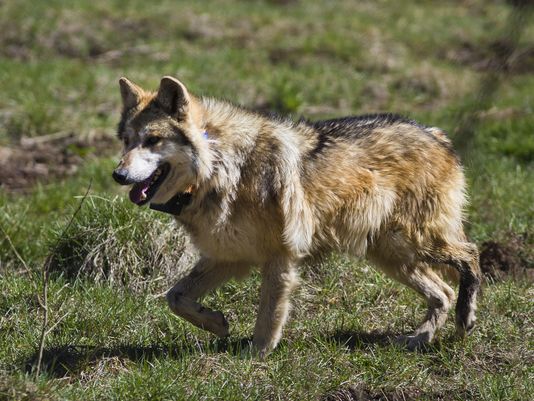
F521 wandered alone, looking for other wolves. F521 had grown old. She was 12 and had lost the dominant status in her pack. She wandered from her home range and met up with her son-in-law and two grandsons.
Toward the end of her life F521 was slowing down. She stayed in one location for many weeks. Her grandsons visited her often. The two young Mexican wolves may have tried to mate with F521, or perhaps they were bringing her food. F521 wasn’t able to kill game like she once was able to do. She had grown thin and weak.
Wildlife managers and biologists avoid giving wild animals’ names. F521 was no exception.
Jeff Dolphin described F521’s life story to illustrate the strength and ability of Mexican wolves raised in captivity and then released in the wild. Dolphin leads the Mexican wolf recovery team for the Arizona Game and Fish Department.
Five agencies co-manage the project. The Interagency Field Team is made up of wildlife specialists from the Arizona Game and Fish Department, U.S. Fish and Wildlife Service, White Mountain Apache Tribe, USDA Forest Service, and USDA Animal and Plant Health Inspection Service, Wildlife Services.
When F521 was 13, she was shot and killed in western New Mexico, near the Arizona border. The gunman is unknown.
To date, she is the longest-lived Mexican wolf in the wild. “There are a lot of wolves out there that are directly related to her,” Dolphin said.
Reintroducing a predator species to its historical habitat manifests dispute between wildlife agencies, environmental organizations, and people who are affected by the animals’ presence on the landscape. The effort to reestablish the Mexican wolf in Arizona and New Mexico has met many challenges because the wolf competes with human use of the land. Wolves roam among domestic animals, threatening the livelihood of ranchers and perhaps altering the future of public land and the wilderness. Despite differences, and in some cases, opposition to the reintroduction of the Mexican wolf, the challenges have been met with sometimes ingenious, and sometimes practical and straightforward solutions.
“The reintroduction of the Mexican wolves was the most difficult of any projects to reintroduce wolves anywhere,” L. David Mech said. Mech is a senior research scientist at the Northern Prairie Research Center with the U.S. Geological Survey. He has studied wolves for almost 60 years.
“The animals were all captive-bred and lacked the skills to survive in the wild,” Mech said. Even though the wolves were catching elk, initially they also attacked livestock and roamed near human activity. “They were released in an environment that lacks large, expansive wilderness areas free of livestock.”
Conflict was inevitable.
On Their Own
When the first captive-raised Mexican wolves were released into the wild in 1998, no one knew what the outcome would be. In captivity the wolves were protected. They were fed. They didn’t hunt or raise pups while exposed to harsh winter conditions.
Once the wolves were released some supplemental food was provided, but the wolves would have to rely on instinct to survive. F521’s release was part of the test for the future of the Mexican wolf in the wild.
F521 had been brought into the Mexican wolf restoration project from the Cheyenne Mountain Zoo in Colorado Springs, Colorado, in 2000. She was taken to a pre-release facility in east-central New Mexico, where she mated with M507.